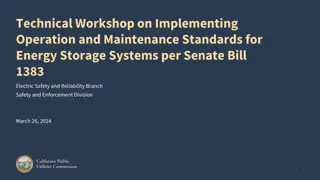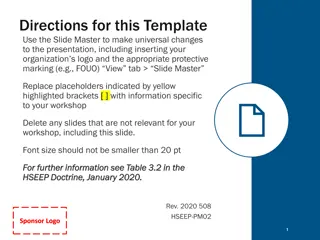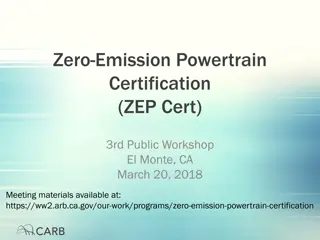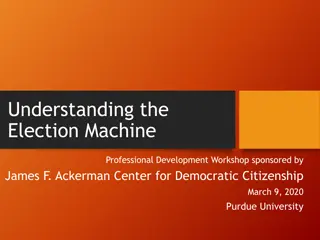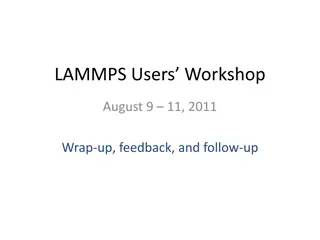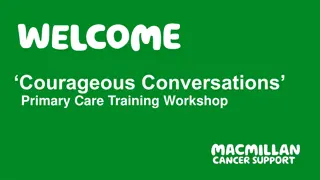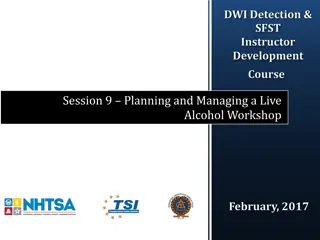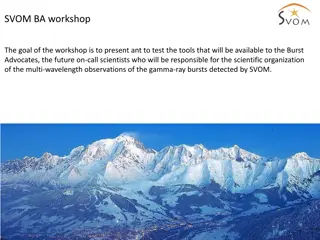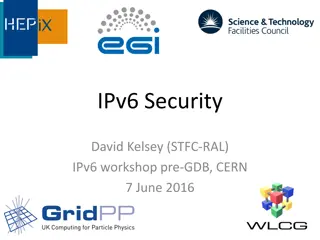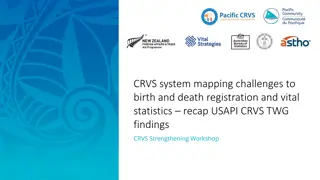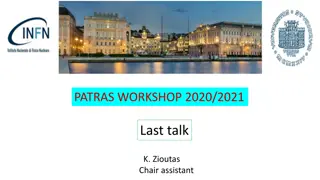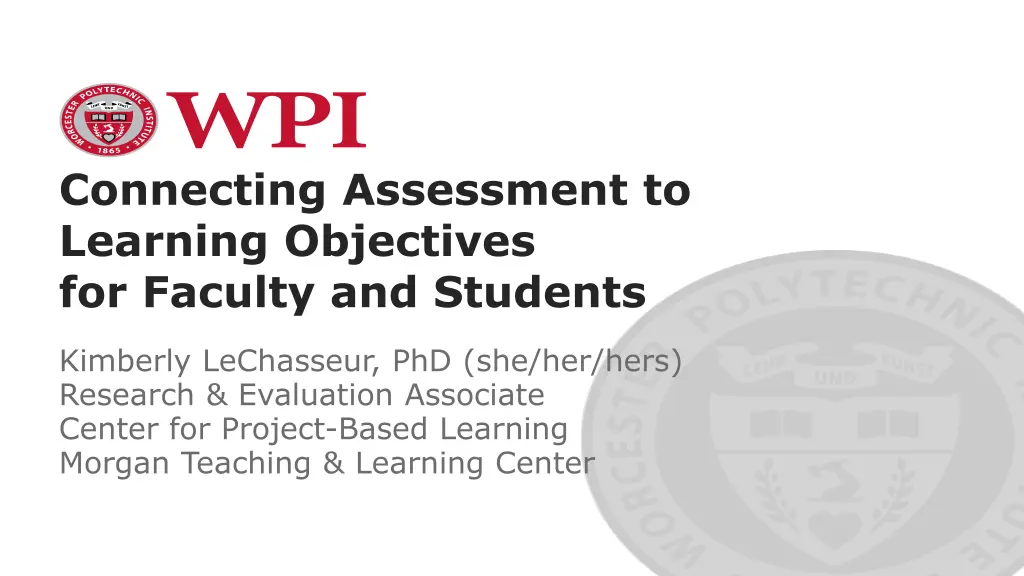
Connecting Assessment to Learning Objectives for Effective Project-Based Learning
Explore the essential learning objectives related to assessment in project-based learning environments, including types of assessment, backward design, and support development, presented through examples of assessing ethics in action. Discover how to align assessment with learning objectives to enhance student engagement and achievement.
Download Presentation

Please find below an Image/Link to download the presentation.
The content on the website is provided AS IS for your information and personal use only. It may not be sold, licensed, or shared on other websites without obtaining consent from the author. If you encounter any issues during the download, it is possible that the publisher has removed the file from their server.
You are allowed to download the files provided on this website for personal or commercial use, subject to the condition that they are used lawfully. All files are the property of their respective owners.
The content on the website is provided AS IS for your information and personal use only. It may not be sold, licensed, or shared on other websites without obtaining consent from the author.
E N D
Presentation Transcript
Connecting Assessment to Learning Objectives for Faculty and Students Kimberly LeChasseur, PhD (she/her/hers) Research & Evaluation Associate Center for Project-Based Learning Morgan Teaching & Learning Center
What are our learning objectives? 1. Illustrate a variety of assessment types appropriate for project-based learning 2. Apply backward design to assessing project-based learning 3. Formulate a plan to develop supports for student or faculty learning (or at least begin to do so!) 2
Whats your plan to backwards design assessment of an experiential education activity? Learning Objectives: What do you need to learn with this assessment? Ownership Allies: Who needs to own these learning objectives? Who can support you in making decisions and implementing them? Assessment Needs: What must be involed for your assessment to be successful? 3
Example 1: Assessing Ethics in Action Student Learning Objectives Student Learning Objectives Theory Theory Demonstrate the ability to identify ethically complex situations in their professional lives; Lecture (~2 days in a semester) An example of the consequences of ethical failures in engineering Class discussion of multiple professional codes of ethics And Practice And Practice Be able to identify conflicts between relevant ethical philosophies or professional codes of ethics and potential courses of actions they may take in response to a particular ethically complex situation; and, Role-playing game, the Sand Mafia (~2 days in a semester) Background content on the Sand Mafia Stakeholder Role Cards A Stakeholders Meeting Optional: Complications Cards Be able to select and justify their selection of the most ethical course of action in response to a particular ethically complex situation. Worcester Polytechnic Institute 4
Example 1: Assessing Ethics in Action Student Learning Objectives Student Learning Objectives Initial Assessment Plans Initial Assessment Plans Demonstrate the ability to recognize ethically complex situations in their professional lives Be able to identify relevant ethical philosophies or professional codes of ethics Choose potential courses of actions they may take in response to a particular ethically complex situation Be able to select and justify their selection of the most ethical course of action in response to a particular ethically complex situation The instructor has the option to assess the student achievement of these learning outcomes as consistent with the rest of their course (ie, quiz, exam, take-home exam, discussion, etc.) A final reflection assignment is recommended, combined with a brief survey to assess student attainment or progress towards learning outcomes. Worcester Polytechnic Institute 5
Assessment Design Choices: An Organizer Using Bloom s Taxonomy Bloom s Taxonomy Level Common Verbs Used in Learning Objectives Process & Product Assessment Options Exam Question Types Creating Can the learner create a new product or perspective? Evaluating Can the learner justify a stand or decision? Analyzing Can the learner identify relationships among parts? Applying Can the learner use information in a new way? Understanding Can the learner explain ideas or concepts? Design, create, develop, formulate, construct, assemble, generate Stakeholder assessment, peer review, value proposition Not recommended Evaluate, argue, appraise, select, propose, assess, determine Conference proposal, poster, position paper, peer review Not recommended Critique, differentiate, distinguish, examine, test, compare, contrast Poster, infographics, lab reports/ team activity reports Problem sets Choose, demonstrate, illustrate, interpret, solve, operate, employ Labeling diagrams, problem sets, short response prompts Demonstrations, infographics, observation, skills checklists Describe, classify, explain, discuss, identify, locate, translate, report Identification questions, short response prompts Journal entries, lab reports/ team activity reports Remembering Can the learner recall important information? Define, list, repeat, recall, state, indicate, choose the correct option Exams & quizzes (fill-in the blank, multiple choice, definitions) Not recommended Worcester Polytechnic Institute 6
Assessment Design Choices: An Organizer Using Bloom s Taxonomy Which levels of Bloom s Taxonomy Bloom s Taxonomy Level Common Verbs Used in Learning Objectives Appropriate Exam Question Types are the student learning objectives for this role-playing game? Non-Exam Assessment Options Creating Can the learner create a new product or perspective? Evaluating Can the learner justify a stand or decision? Analyzing Can the learner identify relationships among parts? Applying Can the learner use information in a new way? Understanding Can the learner explain ideas or concepts? Design, create, develop, formulate, construct, assemble, generate Stakeholder assessment, peer review, value proposition Not recommended Demonstrate the ability to recognize ethically complex situations in their professional lives Evaluate, argue, appraise, select, propose, assess, determine Conference proposal, poster, research paper, peer review Not recommended Be able to identify relevant ethical philosophies or professional codes of ethics Critique, differentiate, distinguish, examine, test, compare, contrast Poster, infographics, lab reports/ team activity reports Problem sets Choose potential courses of actions they may take in response to a particular ethically complex situation Choose, demonstrate, illustrate, interpret, solve, operate, employ Labeling diagrams, problem sets, short response prompts Demonstrations, infographics, observation, skills checklists Describe, classify, explain, discuss, identify, locate, translate, report Identification questions, short response prompts the most ethical course of action in response to a particular ethically complex situation Journal entries, lab reports/ team activity reports Be able to select and justify their selection of Remembering Can the learner recall important information? Define, list, repeat, recall, state, indicate, choose the correct option Exams & quizzes (fill-in the blank, multiple choice, definitions) Not recommended Worcester Polytechnic Institute 7
Assessment Design Choices: An Organizer Using Bloom s Taxonomy Bloom s Taxonomy Level Common Verbs Used in Learning Objectives Process & Product Assessment Options Exam Question Types Creating Can the learner create a new product or perspective? Evaluating Can the learner justify a stand or decision? Analyzing Can the learner identify relationships among parts? Applying Can the learner use information in a new way? Understanding Can the learner explain ideas or concepts? Design, create, develop, formulate, construct, assemble, generate Stakeholder assessment, peer review, value proposition Not recommended Evaluate, argue, appraise, select, propose, assess, determine Conference proposal, poster, position paper, peer review Not recommended Critique, differentiate, distinguish, examine, test, compare, contrast Poster, infographics, lab reports/ team activity reports Problem sets Choose, demonstrate, illustrate, interpret, solve, operate, employ Labeling diagrams, problem sets, short response prompts Demonstrations, infographics, observation, skills checklists Describe, classify, explain, discuss, identify, locate, translate, report Identification questions, short response prompts Journal entries, lab reports/ team activity reports Remembering Can the learner recall important information? Define, list, repeat, recall, state, indicate, choose the correct option Exams & quizzes (fill-in the blank, multiple choice, definitions) Not recommended Worcester Polytechnic Institute 8
Ethical Reasoning VALUE Rubric Modified Exceeds Professional Expectations (5) Meets Professional Expectations (4) Meets Minimum Expectations (3) Approaches Expectations (2) Does Not Meet Expectations (1) Student understands ethical issues when presented in a complex, multilayered, ambiguous context. Student acknowledges basic & obvious ethical issues & grasps the full complexity & situational conditions around them. Student acknowledges basic & obvious ethical issues & grasps some of the complexity &/or situational conditions, but incompletely articulates the full complexity of the dilemma. Student acknowledges basic & obvious ethical issues, but fails to grasp complexity or situational conditions around them. Student does not acknowledge basic & obvious ethical issues as dilemmas. Recognizing Ethical Issues Student names a major perspective/concept in describing the ethical dilemma & accurately explains the details of the perspective/concept while justifying their analysis. Student names a major perspective/concept in describing the ethical dilemma, presents the gist of the perspective/ concept, and gives some explanation of the details to justify their analysis, but has some inaccuracies in details &/or in argumentation. Student names a major perspective/concept in describing the ethical dilemma & presents the gist of the perspective/ concept, but does not go into sufficient detail to justify their analysis. Student names a major perspective/concept in describing the ethical dilemma, but does not provide even a basic description of what that perspective/concept entails. Student describes an ethical dilemma without referencing any specific ethical perspective/ concept. Understanding Different Ethical Perspectives/ Concepts Worcester Polytechnic Institute 9
Ethical Reasoning VALUE Rubric Modified Exceeds Professional Expectations (5) Meets Professional Expectations (4) Meets Minimum Expectations (3) Approaches Expectations (2) Does Not Meet Expectations (1) Student states a position & its alternatives, accurately describes the objections to, assumptions, & implications of each, connects them, & provides an effective defense of the final position. Student states a position & its alternatives, describes the objections to, assumptions, & implications of each, & connects them, but there are some inaccuracies. Student states a position & its alternatives & describes the objections to, assumptions, & implications of each, but without relating them to each other or justifying the final position. Student states a position but does not state objections to, assumptions, & limitations of the declared position & its alternatives. Student fails to clearly state a position regarding a particular ethical issue. Evaluating Different Ethical Perspectives/ Concepts Student independently applies ethical perspectives/concepts to an ethical question accurately & considers the range of implications in their full complexity. Student provides an original ethical stance & applies ethical perspectives/ concepts accurately, but does not consider the specific implications of the application in depth. Student provides an original ethical stance & applies ethical perspectives/ concepts, but with some inaccuracies &/or underdeveloped argumentation. Student applies ethical perspectives/concepts to an ethical question when prompted with an ethical dilemma, but cannot provide & analyze a new position independently. Student does not apply ethical perspectives/ concepts to an ethical question when prompted to do so. Applying Ethical Perspectives/ Concepts Worcester Polytechnic Institute 10
Rubrics for Student Learning Outcomes in Process & Product Assessment Worcester Polytechnic Institute 11
Example 2: Assessing Leadership & Team Skills Change in ABET Requirements Change in ABET Requirements Practice Practice Senior lab courses 7 labs over 2 terms/full semester Teams of 3-4 students Prelab, written report, presentation Capstone 1 open-ended design project Teams of 3-4 students Final written report Intervention for dysfunctional teams only Document the problem, strategies to fix issues, the outcomes Old Learning Objective: an ability to function on multi- disciplinary teams New Learning Objective: an ability to function effectively on a team whose members together provide leadership, create a collaborative and inclusive environment, establish goals, plan tasks, and meet objectives Worcester Polytechnic Institute 12
Ownership Allies University Community Accreditation processes Value proposition of our signature PBL pedagogy Faculty Don t go it alone! Each course relates to the Big Picture Students Framing expectations for the learning experience Skills as an explicit goal Worcester Polytechnic Institute 13
Whats your plan to backwards design assessment of an experiential education activity? Learning Objectives: What do you need to learn with this assessment? Ownership Allies: Who needs to own these learning objectives? Who can support you in making assessment decisions and implementing them? Assessment Needs: What must be involved for your assessment to be successful? 14
Weekly Team Reports Data Collected Data Collected Assessment Practice Assessment Practice Team member roles Requires students to specify leader, teamwork reporter, assignment preparer, & workers Prompts students to be rotated, some roles have multiple team members) Flexibility to Customize Implementation in Courses Three Functions Educative: Sets explicit expectations and builds good habits (eg, self- awareness, attention to team dynamics) Formative: Provides opportunities for regular feedback (eg, Damien has been team leader each week; remember to rotate ) Summative: Provides evidence of trends in student outcomes & faculty responses to issues for ABET accreditation process Goals for the Week & Task Planning Worker Responsibilities Successes/Accomplishments Problem Areas Comments (if any) Worcester Polytechnic Institute 15
Whats your plan to backwards design assessment of an experiential education activity? Learning Objectives: What do you need to learn with this assessment? Ownership Allies: Who needs to own these learning objectives? Who can support you in making decisions and implementing them? Assessment Needs: What must be involved for your assessment to be successful? 16
Questions? kalechasseur@wpi.edu Center for Project-Based Learning


